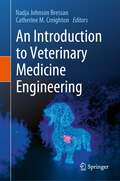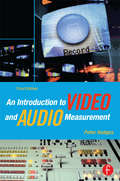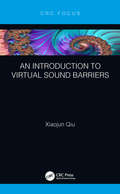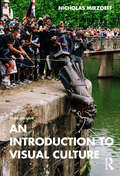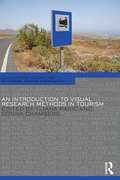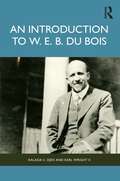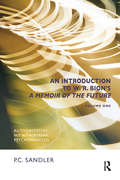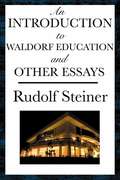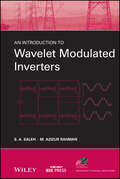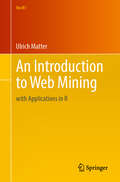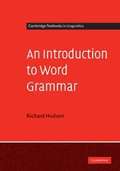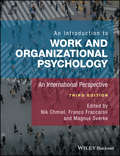- Table View
- List View
An Introduction to Unreal Engine 4
by Andrew SandersThis book serves as an introduction to the level design process in Unreal Engine 4. By working with a number of different components within the Unreal Editor, readers will learn to create levels using BSPs, create custom materials, create custom Blueprints complete with events, import objects, create particle effects, create sound effects and combine them to create a complete playable game level. The book is designed to work step by step at the beginning of each chapter, then allow the reader to complete similar tasks on their own to show an understanding of the content. A companion website with project files and additional information is included.
An Introduction to Urban Geography (Routledge Library Editions: Urban Studies #22)
by John R. ShortThis book, first published in 1984, is an attempt to make students aware of the variety in the urban condition and to introduce them to some of the relationships operating between space and society. From the broad aim of seeking to show the relationship between urbanism and society flows a number of sub-themes, including the importance of cross-cultural comparisons and contrasts, re-distributional consequences and the role of government. This book will be of interest to first- and second-year students of urban studies and human geography.
An Introduction to Using Mapping Sentences
by Paul M. Hackett Katelyn LustigThis book acts as an introductory guide to understanding and using the mapping sentence as a tool in social science and humanities research. The book fills the need for a concise text that simply instructs how and when to use a mapping sentence and provides practical examples. Mapping sentences are a major research component and tool of facet theory. The book begins by covering the background to mapping sentence, including the philosophy and theory underpinning it. The following chapter discuss what mapping sentence is, what different kinds of mapping sentences exist, and knowing when and which to use it in a given situation. The book then moves into describing how to write a mapping sentence and how to analyse the information gained from mapping sentence research. It ends with a consideration of the future developments of mapping sentences and their applications across the social sciences and humanities, including in particular psychology, marketing, behavioural biology, art and health.
An Introduction to Using Theory in Social Work Practice
by James A. ForteAn Introduction to Using Theory in Social Work Practice equips the reader to use fourteen key social work theories to guide each phase of the planned change process, from engagement through to evaluation. Suitable for a generalist approach, this book illustrates the value of applying theory to practice in a variety of social work roles, across diverse fields and facing assorted challenges. <P><P> The first section provides a practical foundation for beginning to use theory in your social work practice. <P><P> Section two looks at how you can translate and integrate fourteen theories commonly found in social work across each phase of the planned change process. The theories discussed are: behavioural, interpretive anthropology, psychodynamic, evolutionary biology, cognitive, symbolic interactionism, strengths, social constructionism exchange economics, role, ecological, critical, feminist, and systems theory. <P><P> The final section addresses some key issues for real life social work practice, including common barriers to using theory in practice, the potential for multi-professional communication and theory-sharing, and developing an integrative theoretical model for your own personal practice. <P><P> Linking to core competencies identified by the Council of Social Work Education, this text supports social work students and practitioners in developing vital skills, including critical thinking, applying theory and the effective use of the planned change process.
An Introduction to Utilitarianism: From Theory to Practice
by William MacAskill Prof. Richard Chappell Mr. Darius MeissnerAn Introduction to Utilitarianism: From Theory to Practice is a state-of-the-art text, simultaneously accessible to introductory students and informative for more advanced readers. Two key features set it apart. First, its comprehensive coverage of the arguments for and against utilitarianism is unparalleled. Second, it takes seriously the practical implications of utilitarianism for how we should live, with a particular emphasis on utilitarianism's impartial beneficence and its focus on effectiveness. Guided by the conviction that practical ethics is more about how best to use our limited time and resources than which victims to hit with trolleys in thought experiments, its practical upshots should prove amenable to utilitarians and non-utilitarians alike.
An Introduction to Value-at-Risk
by Carol Alexander Moorad ChoudhryThe value-at-risk measurement methodology is a widely-used tool in financial market risk management. The fifth edition of Professor Moorad Choudhry's benchmark reference text An Introduction to Value-at-Risk offers an accessible and reader-friendly look at the concept of VaR and its different estimation methods, and is aimed specifically at newcomers to the market or those unfamiliar with modern risk management practices. The author capitalises on his experience in the financial markets to present this concise yet in-depth coverage of VaR, set in the context of risk management as a whole.Topics covered include:Defining value-at-riskVariance-covariance methodologyPortfolio VaRCredit risk and credit VaRStressed VaRCritique and VaR during crisisTopics are illustrated with Bloomberg screens, worked examples and exercises. Related issues such as statistics, volatility and correlation are also introduced as necessary background for students and practitioners. This is essential reading for all those who require an introduction to financial market risk management and risk measurement techniques.Foreword by Carol Alexander, Professor of Finance, University of Sussex.
An Introduction to Variational Calculus: Applications in Image Processing
by Hebert MontegranarioThis textbook introduces variational calculus and regularization methods for inverse problems, seamlessly blending classical concepts with contemporary computational applications, particularly in the field of image processing. The classical perspective draws upon foundational topics explored by pioneers such as Euler and Lagrange, establishing a solid theoretical groundwork. In recent decades, the advent of disciplines such as computer vision has expanded the horizons of variational calculus, showcasing its effectiveness in addressing complex problems that necessitate computational solutions. Consequently, this book places a strong emphasis on the synergy between mathematical theory, practical applications, and algorithmic development. To ensure the text is comprehensive and accessible, essential principles of functional analysis and Fourier analysis are incorporated, facilitating a deeper and more nuanced understanding of the applications presented. Covering both classic and more recent aspects of variational calculus, this book suggests that many topics of modern technology such as computer vision, robotics and especially digital image processing can be formulated in terms of variational problems.
An Introduction to Veterinary Medical Ethics
by Bernard E. RollinOne of the most difficult issues that confronts veterinarians and staff today concerns the profession's obligation to the animal and the sometimes conflicting demands from clients, peers and society. The veterinarian's role has become more complex with new ethical challenges posed by issues such as growing public awareness regarding animal welfare, increasing economic value of companion animals, growth of veterinary specialization, experimentation with alternative and complementary medicine, and concern for pain management and mental well-being of animals. Written by an acknowledged pioneer in veterinary ethics, An Introduction to Veterinary Medical Ethics addresses the ethical challenges that veterinarians face daily as they seek to balance obligations to animal, client, peers, society and self. The book offers a highly readable and approachable introduction to the nature of ethical theory, reasoning and decision-making, and its practical application to veterinary medicine. Now with over 100 real-life veterinary case histories and analysis, this edition also includes new discussions of animal pain, distress and happiness, ethics of critical care, alternative medicine, legal status and value of animals, and Aesculapian authority. An Introduction to Veterinary Medical Ethics: Theory and Cases, Second Edition is recommended as essential reading for all veterinary students and practitioners, as well as those interested in general animal welfare. New edition from an acknowledged pioneer in veterinary ethics; Addresses ethical challenges that veterinary medicine, with over 100 real-life cases; Includes new discussion of legal status and value of animals, alternative medicine, Aesculapian authority, ethics and critical care, and animal pain, distress and happiness; Ideal for veterinary students and practitioners
An Introduction to Veterinary Medicine Engineering
by Nadja Johnson Bressan Catherine M. CreightonDo cephalopods change color when under distress? Is the reptilian heart analogous to a diaphragm positive displacement pump? Are digital twins the answer for animal experimentation? This book explores the new field of veterinary engineering science and discusses how to better measure vital signs in exotic and companion animals. A vast opportunity exists for developing novel technologies that target reductions to the number of invasive procedures patients are subjected to. We examine improvements to animal care and enhancement of animal welfare while creating a more sustainable veterinary healthcare ecosystem. The authors address the challenges engineers face in designing healthcare equipment for animals and how the field of veterinary engineering contributes to traditional veterinary medicine. This book brings a novel field of engineering to train future veterinarians and engineers on design and application of technology to veterinary medicine.Serves as a learning resource for the training and education of veterinary students, veterinarians and engineersDemonstrates through experiments and case studies the merging point between engineering and veterinary medicineDiscusses concepts and issues associated with engineering and veterinary medicineIllustrates veterinary challenges using an engineering-design approachProvides examples of veterinary applications with successful outcomes, incorporating step-by-step directions for engineers
An Introduction to Video and Audio Measurement
by Peter HodgesWhat do we measure and why? Peter Hodges explains the answer to this question in approachable language and with clear illustrations. Newcomers to the video industry, as well as those already established, will find this uniquely readable guide to the basics of a complex subject. Building on the success of the two previous editions of this popular title and covering both analog and digital video, the third edition includes new sections on audio measurement, high definition video, and innovative techniques of test and measurement.
An Introduction to Virtual Sound Barriers
by Xiaojun QiuA virtual sound barrier is an active noise control system that uses arrays of loudspeakers and microphones to create a useful size of quiet zone and can be used to reduce sound propagation, radiation, or transmission from noise sources or to reduce noise level around people in a noisy environment. This book introduces the history, principle, and design methods of virtual sound barriers first, and then describes recent progress in research on the systems. Two virtual sound barrier systems, i.e., planar virtual sound barrier system and three-dimensional virtual sound barrier system, are discussed including applications, limitations and future direction discussions.
An Introduction to Visual Culture
by Nicholas MirzoeffIn the fully rewritten third edition of this classic text, Nicholas Mirzoeff introduces visual culture as visual activism, or activating the visible. In this view, visual culture is a practice: a way of doing, making, and seeing. The 12 new chapters begin with five foundational concepts, including Indigenous ways of seeing, visual activism in the wake of slavery, and unfixing the gaze. The second section outlines three currently successful tactics of visual activism: removal of statues and monuments; restitution of cultural property; and practices of repair and reparations. The final section addresses catastrophe and trauma, from Palestine’s Nakba to the climate disaster and the intersections of plague and war. Each section also includes new, in-depth case studies called "Visualizations," ranging from oil painting to Kongo power figures and the mediated practice of taking a knee. Engaging with questions of racializing, colonialism, and undoing gender throughout, this edition maps the activist turn in the field since 2014 and sets directions for its future expansion. This is a key text in visual culture studies and an essential resource for research and teaching in the field.
An Introduction to Visual Research Methods in Tourism (Contemporary Geographies of Leisure, Tourism and Mobility)
by Donna Chambers Tijana RakićAn Introduction to Visual Research Methods in Tourism is the first book to present, discuss and promote the use of a range of visual methods in tourism studies. It introduces methods ranging from the collection of secondary visual materials for the purposes of analysis (such as postcards, tourism brochures, and websites) and the creation of visuals in the context of primary research (such as photography, video and drawings), to the production of data through photo-elicitation techniques. The book promotes thoroughly underpinned interdisciplinary visual tourism research and includes an exploration of many key philosophical, methodological and inter-disciplinary approaches. Comprised of five parts: introduction; paradigms, academic disciplines and theory; methods; analysis and representation; and conclusion. This volume informs and inspires its readers through a reliance on theory, examples from tourism studies conducted in various geographical locations and through key pedagogical features such as annotated further readings, practical tips boxes and concise chapter summaries. This book will be of interest to experienced visual tourism researchers, scholars wishing to incorporate visual methods in their studies of tourism for the very first time, as well as students on undergraduate, postgraduate or doctoral programmes who are contemplating the incorporation of visual methods in their studies of tourism.
An Introduction to W. E. B. Du Bois
by Earl Wright II Kalasia S. OjehAn Introduction to W. E. B. Du Bois examines the historical contributions to social science and the continuing relevance of the work of W. E. B. Du Bois in an accessible manner. The first volume of its kind, it places the theories of Du Bois in context, showing how the socio‑racial environment in which he grew up and came of age influenced the development of his thought. In addition to covering well‑known concepts such as double consciousness, the veil, and religious fatalism, the authors discuss Du Bois’ uncoined theories emanating from the Atlanta University Studies, as well as his contributions to the development of Black sociology and research methodology. A groundbreaking contextualization and summary of the importance of Du Bois’ work to sociology and sociological theory, this book constitutes a much‑needed resource for scholars and students seeking to understand this scholar’s significance to the social sciences beyond the elementary level.
An Introduction to W.R. Bion's 'A Memoir of the Future': Authoritative, Not Authoritarian, Psychoanalysis
by P.C. SandlerIn the last years of his life Bion gathered unusual manuscripts handwritten in his tidy lettering that assumed the form of a trilogy. Finely typed and edited by his dedicated wife, they were named A Memoir of the Future. Many of the themes of this book were already evident in Transformations and Attention and Interpretation. These earlier books provide many of the theories whose practical counterpart finally found a form in the trilogy: as Bion himself noted, "the criteria for a psychoanalytic paper are that it should stimulate in the reader the emotional experience that the writer intends, that its power to stimulate should be durable, and that the emotional experience thus stimulated should be an accurate representation of the psychoanalytic experience that stimulated the writer in first place." Was Bion true to his word? It is perhaps left to the reader to answer this question. The present book is an attempt to indicate the view that Bion's attempt was to present the burning flame itself - rather than presenting static photographs of the fire.
An Introduction to W.R. Bion's 'A Memoir of the Future': Facts of Matter or a Matter of Fact?
by P.C. SandlerIn the last years of his life Bion gathered unusual manuscripts handwritten in his tidy lettering that assumed the form of a trilogy. Finely typed and edited by his dedicated wife, they were named A Memoir of the Future. Many of the themes of this book were already evident in Transformations and Attention and Interpretation. These earlier books provide many of the theories whose practical counterpart finally found a form in the trilogy: as Bion himself noted, "the criteria for a psychoanalytic paper are that it should stimulate in the reader the emotional experience that the writer intends, that its power to stimulate should be durable, and that the emotional experience thus stimulated should be an accurate representation of the psychoanalytic experience that stimulated the writer in first place." In this second volume of a much needed introduction to Bion's last work, A Memoir of the Future, Paulo Cesar Sandler continues his detailed and insightful "prelude" to a work many readers have found "obscure, complicated and difficult".
An Introduction to Waldorf Education and Other Essays
by Rudolf SteinerCollected here are fourteen essays by Rudolf Steiner covering subjects such as Waldorf Education, The Reordering of Society, The Human Soul, Karma, and Knowledge. These essays are informative and lively. Rudolf Steiner was an Austrian philosopher, literary scholar, educator, artist, playwright, social thinker, and esotericist. His contributions to society were immense.
An Introduction to Water Quality Science: Significance and Measurement Protocols
by Sourav DasThis book discusses the significance of water quality parameters in aquatic ecosystems, offering a concise and practical measurement methodology for early career researchers and post-graduate students in the fields of environmental science, oceanography, and aquatic science . The keys topics covered include aquatic sampling, basics of physicochemical properties and carbonate chemistry of aquatic science , the importance of nutrients in natural water bodies, biological productivity in aquatic ecosystems, aquatic pollution, and statistical analyses of different types of water science data. Several parameters such as microplastics, dimethylsulfoniopropionate and polychlorinated biphenyls have also been incorporated in the book for comprehensive coverage of the topic. The book is meant as a practical guide for beginners and young researchers using a clear writing style and practical examples, highlighting the significance of water science parameters and their measurement protocols in aquatic environments.
An Introduction to Wavelet Modulated Inverters, 1st Edition
by S. A. Saleh M. Azizur RahmanThe introductory chapter briefly presents the fundamental topologies and operation of power inverters. The second chapter contains a description of wavelet basis functions and sampling theory with particular reference to the switching model of inverters. Chapter three outlines the connection between the non-uniform sampling theorem and wavelet functions to develop an ideal sampling-reconstruction process to operate an inverter for obtaining its optimal performances. The scale based linearly combined basis functions are developed in chapter four in order to successfully operate single phase wavelet modulated inverters. Chapter four also contains the development of the non-dyadic type multiresolution analysis, that are responsible for sampling and recontruction of three continuous time reference modulating signals for three phase inverters. The performances of single phase wavelet modulated inverters for static, dynamic and non-linear loads are presented in chapter five, while chapter six contains the simulation and experimental performances of three phase wavelet modulated voltage source inverters for different loads at various operating conditions. This book presents the latest technology in the advancing power electronics field.
An Introduction to Waves and Oscillations in the Sun (Astronomy and Astrophysics Library #400)
by A. Satya Narayanan"An Introduction to Waves and Oscillations in the Sun" is intended for students and researchers who work in the area of solar and astrophysics. This book contains an introduction to the Sun, basics of electrodynamics, magneto-hydrodynamics for force-free and current-free fields. It deals with waves in uniform media with relevance to sound waves and Alfven waves, and with waves in non-uniform media like surface waves or waves in a slab and cylindrical geometry. It also touches on instabilities in fluids and observational signatures of oscillations. Finally, there is an introduction to the area of helio-seismology, which deals with the internal structure of the Sun.
An Introduction to Web Mining: with Applications in R (Use R!)
by Ulrich MatterThis book is devoted to the art and science of web mining — showing how the world's largest information source can be turned into structured, research-ready data. Drawing on many years of teaching graduate courses on Web Mining and on numerous large-scale research projects in web mining contexts, the author provides clear explanations of key web technologies combined with hands-on R tutorials that work in the real world — and keep working as the web evolves. Through the book, readers will learn how to - scrape static and dynamic/JavaScript-heavy websites - use web APIs for structured data extraction from web sources - build fault-tolerant crawlers and cloud-based scraping pipelines - navigate CAPTCHAs, rate limits, and authentication hurdles - integrate AI-driven tools to speed up every stage of the workflow - apply ethical, legal, and scientific guidelines to their web mining activities Part I explains why web data matters and leads the reader through a first &“hello-scrape&” in R while introducing HTML, HTTP, and CSS. Part II explores how the modern web works and shows, step by step, how to move from scraping static pages to collecting data from APIs and JavaScript-driven sites. Part III focuses on scaling up: building reliable crawlers, dealing with log-ins and CAPTCHAs, using cloud resources, and adding AI helpers. Part IV looks at ethical, legal, and research standards, offering checklists and case studies, enabling the reader to make responsible choices. Together, these parts give a clear path from small experiments to large-scale projects. This valuable guide is written for a wide readership — from graduate students taking their first steps in data science to seasoned researchers and analysts in economics, social science, business, and public policy. It will be a lasting reference for anyone with an interest in extracting insight from the web — whether working in academia, industry, or the public sector.
An Introduction to Womanist Biblical Interpretation
by Nyasha JuniorAn Introduction to Womanist Biblical Interpretation provides a much-needed introduction to womanist approaches to biblical interpretation. It argues that womanist biblical interpretation is not simply a byproduct of feminist biblical interpretation but part of a distinctive tradition of African American women's engagement with biblical texts. While womanist biblical interpretation is relatively new in the development of academic biblical studies, African American women are not newcomers to biblical interpretation. Written in an accessible style, this volume highlights the importance of both the Bible and race in the development of feminism and the emergence of womanism. It provides a history of feminist biblical interpretation and discusses the current state of womanist biblical interpretation as well as critical issues related to its development and future. Although some African American women identify themselves as "womanists," the term, its usage, its features, and its connection to feminism remain widely misunderstood. This excellent textbook is perfect for helping to introduce readers to the development and applications of womanist biblical interpretation.
An Introduction to Word Grammar
by Richard HudsonWord grammar is a theory of language structure and is based on the assumption that language, and indeed the whole of knowledge, is a network, and that virtually all of knowledge is learned. It combines the psychological insights of cognitive linguistics with the rigour of more formal theories. This textbook spans a broad range of topics from prototypes, activation and default inheritance to the details of syntactic, morphological and semantic structure. It introduces elementary ideas from cognitive science and uses them to explain the structure of language including a survey of English grammar.
An Introduction to Work and Organizational Psychology: An International Perspective
by Franco Fraccaroli Magnus Sverke Nik ChmielThis fully updated edition of a best-selling textbook provides the most comprehensive introduction to issues in work and organizational psychology with an international perspective; reflecting current advancements in the workplace, the book brings together the expertise of leading thinkers and practitioners. Fully updated third edition of the best-selling textbook on work and organizational psychology now with an international perspective Presents a solid foundation on a range of core topics including working with technology, the impact on employees when organizations change, and maintaining the work-life balance Updated throughout to include recently emerging themes and current views in the field Includes five new case studies covering age management, diversity at the top, resilience development, respect at work and a strategic approach to improving wellbeing in the workplace Provides instructor and student support includes key studies, research close-ups, discussion points and five extensive case studies
An Introduction to Working with the Aging Person Who Is Visually Handicapped (2nd edition)
by Dava GraysonThis book deals with aged blind persons, the ways and means of lending them a helping hand, services available to them, and solving other problems.








